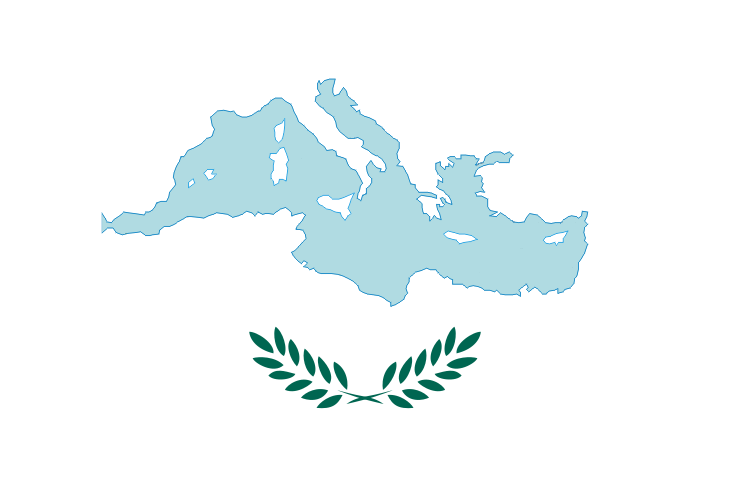

 Italy
Italy  Greece
Greece  Mediterranean
Mediterranean  Spain
Spain  France
France  Germany
Germany  France
France  Germany
Germany  Italy
Italy | Souvla (lamb, pork, chicken cooked on a skewer , garnished with oregano , salt and lemon) Souvlaki (same as souvla but smaller pieces , placed in a pitta bread with salad and tzatziki) Gyros (slices of pork , beef or chicken cooked slowly placed in a pitta bread with salad and tzatziki) Kontosouvli (Large pieces of meat and fat passed on a skewer) Kokoretsi ( traditional Greek dish made of animal giblets and cooked on a skewer) Pastitsio (Baked pasta dish with minced meat and bechamel sauce) Cyprus Ravioli (Ravioli filled with halloumi and mint) Sheftalia (minced pork, chopped onions, bread crumbs, chopped parsley, white pepper and salt) Keftedes (fried meatballs , usually pork , beef , chicken ) Trachanas Soup (is a type of soup with pasta made of flour and milk) Avgolemoni Soup ( type of soup with egg lemon and chicken) Koupes (Finger food sausage shaped made of bulgar wheat and filled with minced meat) Kolokasi (A bulb that is very similar to potato or sweet potato) Poulles ( Fried kolokasi) Patates antinahtes (Small potatoes fried in the pot with lots of salt and coriander) Resi (Wheat cooked with made , dish usually made for traditional cypriot weddings) Easter Pourgouri with Goat (Easter dish made of cuscus with goat meat cooked in a clay pot) Magiritsa Soup (Easter soup made with vegetables, dill, lamb giblets and rice) |
| Souvla (lamb, pork, chicken cooked on a skewer , garnished with oregano , salt and lemon) Souvlaki (same as souvla but smaller pieces , placed in a pitta bread with salad and tzatziki) Gyros (slices of pork , beef or chicken cooked slowly placed in a pitta bread with salad and tzatziki) Kontosouvli (Large pieces of meat and fat passed on a skewer) Kokoretsi ( traditional Greek dish made of animal giblets and cooked on a skewer) Pastitsio (Baked pasta dish with minced meat and bechamel sauce) Cyprus Ravioli (Ravioli filled with halloumi and mint) Sheftalia (minced pork, chopped onions, bread crumbs, chopped parsley, white pepper and salt) Keftedes (fried meatballs , usually pork , beef , chicken ) Trachanas Soup (is a type of soup with pasta made of flour and milk) Avgolemoni Soup ( type of soup with egg lemon and chicken) Koupes (Finger food sausage shaped made of bulgar wheat and filled with minced meat) Kolokasi (A bulb that is very similar to potato or sweet potato) Poulles ( Fried kolokasi) Patates antinahtes (Small potatoes fried in the pot with lots of salt and coriander) Resi (Wheat cooked with made , dish usually made for traditional cypriot weddings) Easter Pourgouri with Goat (Easter dish made of cuscus with goat meat cooked in a clay pot) Magiritsa Soup (Easter soup made with vegetables, dill, lamb giblets and rice) |
Knedlíky or dumplings are the Czech side dish made from wheat or potato flour and boiled in water as a roll and then sliced and served hot. Guláš (pronounced as “goulash“) Goulash (guláš in Czech) is a common dish in pubs.
Braised red cabbage more.... Netherlands
Netherlands sauerkraut, jellied meat and blood sausage are typical Estonian foods.
Apple coffee cake Roasted brussels sprouts with red pepper more.... Mediterranean
Mediterranean  Germany
Germany
 Belgium
Belgium This standard term for a Dutch dinner stands for Aardappel, Vlees, Groenten, or potato, meat and vegetables. A lot of Dutch households tend not to go for an existing dish, so much as a combination of these basic essentials.
Pea soup is a thick, hearty split pea soup with sausage and vegetables, often consumed during winter. A day after preparation, the soup has thickened and more meat is added, after which it becomes snert.
Potato, carrot and onion mash, often eaten in winter, usually with meat on the side.
Green peas soup more....With its rolling hills, fertile land and clear, clean surrounding seas there is much to choose from and all of it packs a flavour punch. Most farms sell garden produce such as milk and eggs, whilst there are a number of grocers, fishmongers, butchers and farmers markets around the island specialising in local fare. Alternatively stop at a country pub, quayside café or fine restaurant to enjoy the rich pickings.
The island has a host of its own local products and ingredients to show off, from local bread, flour, full-flavoured cheeses and luscious lamb to 60 flavours of creamy, rich Manx ice cream. The same people who make the ice cream, Davisons, are also responsible for producing delicious local chocolates. Another local favourite is bonnag, a type of crumbly, fruity cake not dissimilar to a scone.
Perhaps the island’s most famous food though is the Manx kipper, which has been a tradition since the late 1800s; herrings are caught locally in the Irish Sea, then cut, salted and smoked with oak chips to give them a unique flavour. Smoked salmon is a speciality here as well. Look out too for Manx Queenies, queen scallops served with a white or cheese sauce. Crab and lobster are commercially fished. Cod, ling and mackerel are often fished for the table and freshwater trout and salmon can be taken from the local rivers and lakes.
• Queen scallops.
• Spuds and Herrin (boiled potatoes and herring).
• Manx kippers (smoked herring).
• Bonnag (a flat loaf of bread).
• Davison's ice cream, made in Peel.
• Chips, cheese and gravy somewhat like Quebec's poutine.
Pubs usually open Mon-Thurs 1000-2300, Fri-Sat 1000-2400. On Sunday, pubs open 1200-2300. These times can vary according to individual pubs, as 24-hour licensing is now permitted. Special opening hours apply to the Easter and Christmas/New Year periods.
In hotels, a service charge of 10 to 12% is usual, which may be added to the bill. 10 to 15% is usual for restaurants; if this has already been added to the bill, a further tip is not required.
18.
The island’s brewery, Okells is the sole authorized Manx brewery; the ales and lagers they produce are served in pubs all around the island. The Isle of Man also benefits from a law saying that beer can have no ingredient other than water, yeast, hops and malt, meaning that the finished product is typically very tasty. Manx Ale is indigenous to the island; matured in oak casks, it’s imbued with a distinctive flavour and aroma.
• Real Manx Ale.
• Manx whiskey, gin and vodka.
• Kella whiskey.
 Switzerland
Switzerland  Austria
Austria  Germany
Germany  Switzerland
Switzerland
 Austria
Austria
 Germany
Germany
 Belgium
Belgium  France
France  Germany
Germany  Mediterranean
Mediterranean  France
France  Italy
Italy
 Mediterranean
Mediterranean  Germany
Germany  Belgium
Belgium  Spain
Spain  France
France  Italy
Italy  Germany
Germany
 Italy
Italy  Mediterranean
Mediterranean
Non-liquid ingredients in volume converted
|
|||||||
|---|---|---|---|---|---|---|---|
Ingredient |
1 cup |
3/4 cup |
2/3 cup |
1/2 cup |
1/3 cup |
1/4 cup |
2 tablespoons |
| All-purpose wheat flour | 120 g | 90 g | 80 g | 60 g | 40 g | 30 g | 15 g |
| All-purpose sifted wheat flour | 110 g | 80 g | 70 g | 55 g | 35 g | 27 g | 13 g |
| White sugar | 200 g | 150 g | 130 g | 100 g | 65 g | 50 g | 25 g |
| Powdered sugar/Icing sugar | 100 g | 75 g | 70 g | 50 g | 35 g | 25 g | 13 g |
| Brown sugar normally packed | 180 g | 135 g | 120 g | 90 g | 60 g | 45 g | 23 g |
| Corn flour | 160 g | 120 g | 100 g | 80 g | 50 g | 40 g | 20 g |
| Cornstarch | 120 g | 90 g | 80 g | 60 g | 40 g | 30 g | 15 g |
| Rice (not-cooked) | 190 g | 140 g | 125 g | 95 g | 65 g | 48 g | 24 g |
| Macaroni (uncooked) | 140 g | 100 g | 90 g | 70 g | 45 g | 35 g | 17 g |
| Couscous (uncooked) | 180 g | 135 g | 120 g | 90 g | 60 g | 45 g | 22 g |
| Quick oatmeal (uncooked) | 90 g | 65 g | 60 g | 45 g | 30 g | 22 g | 11 g |
| Table salt | 300 g | 230 g | 200 g | 150 g | 100 g | 75 g | 40 g |
| Butter / Margarine | 240 g | 180 g | 160 g | 120 g | 80 g | 60 g | 30 g |
| Shortening | 190 g | 140 g | 125 g | 95 g | 65 g | 48 g | 24 g |
| Fruits and légumes chopped | 150 g | 110 g | 100 g | 75 g | 50 g | 40 g | 20 g |
| chopped walnuts | 150 g | 110 g | 100 g | 75 g | 50 g | 40 g | 20 g |
| Nuts /ground almonds | 120 g | 90 g | 80 g | 60 g | 40 g | 30 g | 15 g |
| Fresh bread crumbs (not packed) | 60 g | 45 g | 40 g | 30 g | 20 g | 15 g | 8 g |
| Dry bread crumbs | 150 g | 110 g | 100 g | 75 g | 50 g | 40 g | 20 g |
| Parmesan grated | 90 g | 65 g | 60 g | 45 g | 30 g | 22 g | 11 g |
| Chocolate chips | 150 g | 110 g | 100 g | 75 g | 50 g | 38 g | 19 g |